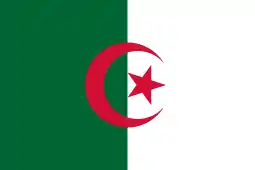Ethnic groups in Algeria
Ethnic groups in Algeria include Arab-Berbers, who represent 99% of the population, though according to the The World Factbook "although almost all Algerians are Berber in origin (not Arab), only a minority identify themselves as primarily Berber, about 40-55% of the total population".[2] Berbers are an indigenous ethnic group of Algeria. Berber linguistic groups include speakers of Central Atlas Tamazight, Chaouis, Kabyle, Taznatit, Tumzabt,[3]Chenouas and Tuaregs. Algeria also has a minority population of Europeans that represents less than 1% of the population.[2]
| Part of a series on the |
| Culture of Algeria |
|---|
 |
| People |
| Art |
The minority European population is predominantly of French, Spanish, and Italian descent.[4] and have interacted with Phoenicians and Romans for centuries. Christianized in Late Antiquity during the Christianization of the Roman Empire, Berbers became Islamized after the Muslim conquest of the Maghreb under the Umayyad Caliphate.
Berbers
Berbers are the indigenous population of Algeria. Beginning with the Numidian kingdom till the Middle-Ages, Berbers had extensive historical relationships with both Romans and Phoenicians who eventually build Carthage in their own lands. Partially Romanized and Christian during the Roman Empire, the Berbers and their lands were Islamized in the 7th century with the expansion of the Umayyad Empire from Syria. Previous Roman-Berber cities gradually began to become Arabo-Berber cities where an Arabo-Islamic culture was involved. Arabization was considered as a low phenomenon, mostly due to cultural and economical exchanges between the new Maghreb and the old Mashreq of the Arab world until the 12th century with the invasion of the Bedouin tribe Banu Hilal expanded their cultural influence towards the inland areas. Within the few centuries later, the linguistical Arabization of the Maghreb became much more important and dominant.
The Berber-speaking Algerians are divided into many subgroups. The Kabyles, or Kaba’il, mostly farmers, live in the compact mountainous section in the northern part of the country between Algiers and Constantine. The Chaouia, or Shawiyyah, live in the Aurès Mountains of the northeast region. The Chenouas and various similar Zenata groups used to occupy a very large area from Central Algeria to Western Algeria. The Mzab, or Mozabites, include sedentary date growers in the Ued Mzab oasis. Desert groups include the Tuareg and Tuat.
Other ethnic groups
Other ethnic groups in Algeria include Europeans of French (Corsican), Spanish, Italian, and Maltese ancestry, who are estimated at less than 1 percent of the population in 2005. Algeria was also the home of a significant Jewish community, most of which fled after Algeria's independence, with about 70 000 Jews emigrating to France and 10 000 to Israel in that period. Almost all the rest left Algeria during the next seven years and fewer than 100 Jews remained in Algeria as of 1998.
See also
References
- "Africa :: ALGERIA". CIA The World Factbook.
- "Africa: Algeria". The World Factbook. Central Intelligence Agency. 2020-11-04. Retrieved 2020-11-07.
- "Les Berbères en Afrique du Nord". Chaire pour le développement de la recherche sur la culture d'expression française en Amérique du Nord., Université Laval Québec, 2016.
- UNESCO (2009). "Diversité et interculturalité en Algérie" (PDF). UNESCO. p. 9. Archived from the original (PDF) on July 25, 2013.